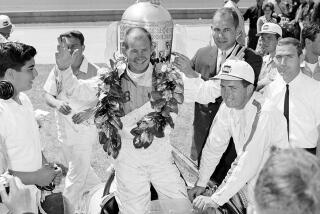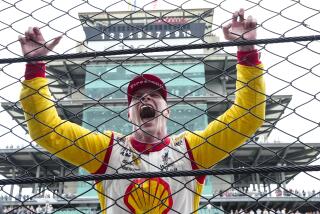INDIANAPOLIS 500 : Being No. 1 at the Finish Is What Counts : Scott Brayton expected to win the pole but knows going the distance in today’s race will be tough.
- Share via
INDIANAPOLIS — Before qualifying began for the Indianapolis 500 this year, Scott Brayton told friends that he expected to win the pole.
He made good, tooling his Menard-powered Lola around Indianapolis Motor Speedway at a 231.604 m.p.h. average for four laps.
For today’s 500-mile race, he’s not so sure of the outcome.
“If we’re still around toward the finish, we might make some trouble for someone,” he said. “We had the speed for qualifying, but there are a lot of other things we have to overcome during the race.”
Reliability, for one.
“We haven’t done a 500-mile test, we’ve been focusing on 200- to 400-mile tests,” Brayton said. “To get the speed we achieved, we had to run the engine extremely hard. We can’t do that on race day and last very long, but if we slow down a little there’s no reason we can’t finish strong.
“We haven’t broken an engine since we came here opening day [May 6] as much as we’ve broken accessories that broke the engine, things like the fuel pump, alternator and dropped belts.”
Because a Menard engine is built specifically for the Indy 500 and does not compete in other Indy car races, there is no guideline to measure its performance. It is a dinosaur by Indy car standards--a highly modified version of the Buick stock block V-6 designed for series 3300 passenger cars in 1984.
Its advantage is that under U.S. Auto Club rules, which govern the 500, it is allowed 55 inches of turbocharger boost, as opposed to the 45 inches allowed in Ford Cosworth, Ilmor Mercedes-Benz and Honda double-overhead cam engines.
“We’re better prepared this year than ever before,” says John Menard, the Eau Claire, Wis., businessman who continued the engine’s development after Buick abandoned it in 1992. “We’ve learned a lot here the last four or five years. Every year we’ve done a little better, although sometimes the results don’t reflect it.”
Last year, Eddie Cheever started 11th and finished eighth in a Menard. Brayton dropped out with engine failure in the other one.
“There are two major problems we have to overcome in the race,” Brayton said. “Traffic is harder for the Menard to deal with than the other engines because of its slower throttle response, and it is more difficult to drive in a race.
“To finish 500 miles we must be perfect with our shifting in and out of the pits. . . . The driver must be very, very careful.”
Cheever, who was Menard’s development driver before leaving to join A.J. Foyt’s team late last year, put it more succinctly:
“With the Menard engine if you over-rev it at the wrong time, it’s like pulling a pin out of a German 1940 hand grenade. You know it’s going to explode but you don’t know when it’s going to explode. It’s a very delicate engine, but when you consider how long ago it was designed and how much power they get out of it, it’s unbelievable.”
On April 12, during a pre-Indy tire test here, the engine broke on Brayton’s car, sending it careening into the fourth turn wall at 234 m.p.h. The car, a ’95 Lola, was destroyed. Miraculously, Brayton walked away with nothing more than a sore ankle.
“It was the last lap of the last day of our test,” Menard said. “It didn’t slow our program, though. We had four other Lolas ready, and Scott didn’t miss a session.”
The decade-old engine has been stretched to its limits. It was designed to produce 160 horsepower, but now puts out in the neighborhood of 850.
“It’s the result of good old American ingenuity,” Brayton said proudly.
Brayton, 36, a second-generation race driver from Coldwater, Mich., who will be in his 14th 500, is the team’s cheerleader. And flag-waver.
“I’m proud to be an American driver in an American race, on the pole in a car with an American engine,” he said.
“If you want to characterize me, you can say I’m a Midwestern person who was born and raised in Michigan, who loves to drive fast cars on weekends . . . and get paid for it.”
His father, Lee, a rookie driver here in 1972, was involved in the early development of the Buick racing engine, and the family’s Brayton Engineering company still supplies some of the parts used to build the Menard engine.
Scott Brayton also owns a commercial hauling company, a sand and gravel company and is an Amway distributor.
“Actually, there are three Scott Braytons,” he said. “One is a race driver, one a businessman and then there is Scott the person. I like the race driver the best, but Scott the person is the nicest.
“My folks bought me a go-kart when I was 5 and I’ve been obsessed with cars ever since,” Brayton said. “When our daughter was born, we named her Carly. That’s a mix of ‘car’ and ‘Lee,’ my dad’s name. My dad would eat, drink and sleep racing. It was ingrained in his soul. In some ways, I’m just like him.”
Before Brayton edged his Menard teammate, former 500 winner Arie Luyendyk, for this year’s pole, his proudest moment came in 1984 when he became the first American driver to exceed 200 m.p.h. with an American-made engine. He ran a lap at 204.638 in a Buick V-6.
“That record is a little-known fact because the British-built Cosworths were running 200 before that, but it meant a lot of me to be the first to do it with an American motor.”
In 1985 he set track records in qualifying, but was bumped off the pole by Pancho Carter, also in a Buick, and started in the middle of the front row.
“Comparing 1985 and today is like comparing 1902 to 1950 because the sport has progressed so much,” Brayton said. “That’s true of the difference in John Menard’s team from 1992 to today too.”
Menard looks and acts like one of the team mechanics, but is a self-made multimillionaire--Forbes magazine lists his worth at $400 million--who owns a chain of 105 retail home improvement stores in the Midwest with 18,000 employees.
In the fall of 1993 he decided to change his racing emphasis from a part-time team to a full-time one.
The change got under way when he built a huge race car garage in Indianapolis, hired veteran crew chief Larry Curry to be team manager and gave him a $6 million-plus budget to prepare cars for one race a year--the Indianapolis 500.
Curry, known as “Big Daddy” to his crew, has 30 employees working on the three Menard cars in today’s race. Buddy Lazier is the third driver.
“Racing is a lot like retail,” Menard said. “It’s all about people. If you have a store with good people, you’re going to do well. It’s the same with racing. Larry, Scott and the rest of the guys have great chemistry, and it paid off last week.
“We worked really hard getting this motor to work the way it does. It started out as a hot rod, built by hot-rodders. It was a low budget operation in the ‘80s, made up of hod-rod parts right off the shelf.
“Now we’re here with the fastest cars on the lot. I have to keep pinching myself to make sure it’s true, but to tell the truth, I probably enjoyed it more in the old days when we were short-handed and I did more myself. Today, I’m a manager more than a doer.”
Menard and Buick came together almost by default. In the early ‘80s, he came to Indianapolis with an Eau Claire neighbor, Herm Johnson, and bankrolled a succession of cars for his friend to drive.
In 1990, after Johnson had retired, Menard got the urge to go racing again.
“I tried to buy an Ilmor [engine] and was told I couldn’t have one because I was not one of the chosen few who had franchises,” he said. “So I got into Buicks because they were available. Later, when I could have had any engine, I didn’t like the lease program. The motors are very expensive, you don’t get to own them, in fact you can’t even touch them. If you want something done, you have to send the motor back to the factory.
“I didn’t like that. I’m a tinkerer. I like to see what can be done with our own ideas. So I stuck with the Buick. And I like what Larry, Scott and myself have come up with.
“Seeing my cars one-two on the front row is absolutely wonderful. To have toys faster than anyone else’s toys brings out the boy in all of us.”
More to Read
Go beyond the scoreboard
Get the latest on L.A.'s teams in the daily Sports Report newsletter.
You may occasionally receive promotional content from the Los Angeles Times.










